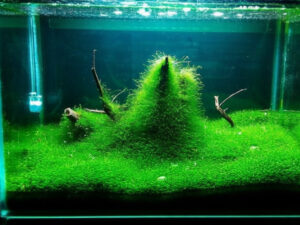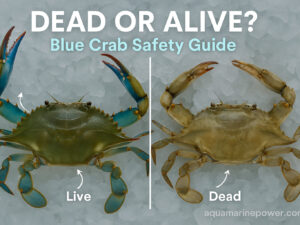Finding mysterious black spots on your crab can be alarming, especially when you're preparing a special seafood dinner. Many seafood lovers worry about safety when they see black discoloration on their crab legs, shells, or even inside the meat.
The good news? Most black spots on crabs are harmless battle wounds or parasite eggs that don't affect meat quality or safety. However, knowing how to identify different types of spots is crucial for safe consumption.
This comprehensive guide covers the four main types of black spots, safety guidelines, identification methods, and expert handling tips to help you enjoy your crab with confidence.
What Are the Black Spots on My Crab? (4 Main Types Explained)
Understanding crab black spots on legs and shells starts with knowing the four main types you might encounter. Each type has distinct characteristics and different implications for food safety.
Battle Wounds and Bruises (Most Common)
The most frequent cause of black spots on crabs is melanin deposits from physical trauma. These spots form when crabs sustain injuries during territorial fights or predator encounters.
According to marine biologists at the California Department of Fish & Wildlife, these melanin spots are the crab's immune response to shell damage. Think of them as nature's version of a bruise that helps protect the damaged area.
These battle scars appear as dark patches on the shell surface and occasionally near joints. They're completely harmless and don't penetrate into the edible meat.
Marine Leech Eggs (Kanibiru)
Those tiny black dots clustered on crab legs? They're likely marine leech eggs, known as kanibiru in the seafood industry. These eggs measure approximately 0.5mm in diameter and appear in strings or clusters.
Surprisingly, crabs with these parasite eggs are often considered higher quality. The presence of eggs indicates the crab hasn't molted recently, meaning fuller, denser meat inside the shell.
Marine leeches lay eggs on crab shells because it provides a mobile nursery. The eggs are harmless to humans and are killed during normal cooking processes.
Pepper Spot Disease
Pepper spot disease specifically affects blue crabs and appears as tiny black specks throughout the tissue. This condition occurs when a crab becomes infected with a parasite that's then infected by another parasite (a hyperparasite).
The disease creates distinctive pinpoint black spots that look like ground pepper scattered through the meat. While not dangerous to humans when properly cooked, affected meat may have an altered texture or taste.
Research from marine pathologists shows this disease is more common in warmer waters and stressed crab populations.
Enzymatic Blackening from Undercooking
Sometimes black discoloration develops after cooking due to an enzyme in crab blood. This enzymatic reaction occurs when crabs aren't cooked at full boil long enough.
The blackening typically starts in body meat and follows veins into leg meat. It may not appear until the second day after cooking, which can confuse home cooks.
Professional processors recommend maintaining a full rolling boil for at least 20 minutes to prevent this issue. The enzyme denatures completely at proper cooking temperatures.
Are Crabs with Black Spots Safe to Eat?
Determining whether your spotted crab is safe requires understanding which conditions are harmless versus those requiring caution. Here's what experts recommend.
When Black Spots Are Harmless?
Most black spots pose no health risk when they meet these criteria:
- Shell-only spots: Discoloration limited to the outer shell
- No odor: Fresh sea smell without ammonia or rot
- Proper cooking: Internal temperature reached 145°F (63°C)
- Firm texture: Meat springs back when pressed
Battle wounds and marine leech eggs fall into this safe category. Even crabs with extensive shell spotting are perfectly edible if the meat inside looks and smells normal.
Warning Signs to Avoid Eating
Why is my crab black inside? This question often signals a potential problem. Avoid consuming crab with these warning signs:
| Warning Sign | What It Means | Action Required |
|---|---|---|
| Black meat throughout | Severe decomposition or disease | Discard entire crab |
| Ammonia smell | Bacterial breakdown | Do not consume |
| Mushy texture | Advanced spoilage | Throw away immediately |
| Gray film on meat | Possible undercooking | Discard to be safe |
Expert Safety Guidelines
The FDA Seafood Guidance recommends inspecting each crab before cooking. Professional processors follow strict protocols for identifying safe versus compromised products.
Industry standards suggest discarding any crab where black discoloration extends more than surface-deep into the meat. When in doubt, it's better to err on the side of caution.
Commercial operations often grade crabs based on shell appearance, but minor spotting doesn't affect the highest grades if meat quality remains excellent.
How to Identify Different Types of Black Spots?
Accurate identification helps you make informed decisions about your seafood. Each type of black spot has unique characteristics.
Visual Identification Guide
Learning to distinguish between spot types becomes easier with practice. Here's what to look for:
Battle Wounds:
- Irregular shaped patches
- Dark brown to black color
- Smooth surface integration
- Random placement on shell
Marine Leech Eggs:
- Uniform tiny dots
- Clustered patterns
- Slightly raised texture
- Often on leg segments
Disease Spots:
- Pepper-like specks
- Throughout meat tissue
- Accompanied by texture changes
- More common in warmer months
Testing Methods
Professional crabbers use these techniques to identify black spots on crab feet and other areas:
The scrape test involves gently scraping the spot with a knife edge. Melanin spots won't come off easily, while parasite eggs may reveal small white larvae underneath.
Check for consistency by examining multiple crabs from the same batch. Environmental factors typically affect all crabs similarly, while individual injuries create random patterns.
Temperature testing can help too. Spots that develop or worsen after cooking often indicate enzymatic issues rather than pre-existing conditions.
Why do Crabs Get Black Spots on Legs and Shells?
Understanding the causes helps prevent issues and ensures you select the best quality crabs. Multiple factors contribute to spot development.
Natural Causes
Crabs live in a challenging environment where physical confrontations are common. Territorial disputes lead to claw strikes that damage shells and create lasting marks.
Predator attacks from fish, birds, and other crabs leave defensive wounds. These injuries trigger melanin production as part of the healing process, similar to how bruising occurs in other marine creatures.
Molting injuries can also cause spots. When crabs shed their old shells, the new soft shell is vulnerable to damage that appears as dark marks once hardened.
Environmental Factors
Water quality significantly impacts crab health and appearance. High pollution levels stress crabs' immune systems, making them more susceptible to infections and abnormal pigmentation.
Seasonal temperature fluctuations affect disease prevalence. Warmer waters typically see higher rates of pepper spot disease and other conditions causing discoloration.
Habitat destruction forces crabs into overcrowded areas, increasing combat injuries. Rocky bottoms versus muddy environments also influence the types and frequency of shell damage.
Processing and Storage Issues
Post-harvest handling greatly affects whether crabs develop black spots. Improper ice coverage allows enzymatic reactions that create discoloration.
Time between capture and processing matters. Crabs held too long in holding tanks may develop stress-related pigmentation changes.
Temperature abuse during transport can accelerate decomposition processes. Maintaining consistent cold chain management prevents many post-harvest spot issues.
Black Spots Inside Crab Meat: Special Considerations
Internal discoloration requires more careful evaluation than external spots. Understanding the causes helps you make safe consumption decisions.
Causes of Internal Discoloration
Deep wounds that penetrate the shell can introduce melanin into the meat. These appear as dark streaks following the injury path.
Undercooking remains the most common cause of meat blackening. The enzyme responsible survives in temperatures below full boiling, creating delayed discoloration.
Advanced disease conditions similar to those affecting other crustaceans can cause systemic blackening. This typically accompanies other signs of poor quality.
Blood pooling in damaged areas creates dark pockets. This occurs when crabs aren't properly drained after cooking.
What to Do If You Find Black Inside?
First, assess the extent of discoloration. Small spots near shell cracks may be removable, while widespread blackening indicates disposal.
For localized spots:
- Cut away affected areas with clean knife
- Inspect surrounding meat carefully
- Check for normal texture and smell
- Discard if any doubt exists
Never attempt to "cook out" black discoloration. If meat shows extensive blackening, the entire crab should be discarded regardless of the cause.
Species-Specific Black Spot Information
Different crab species exhibit varying patterns of black spots. Understanding these differences helps set appropriate expectations.
Snow Crab Black Spots
Snow crabs commonly display black spots near leg joints and knuckles. The cold-water environment creates specific wound-healing patterns.
Industry professionals consider moderate shell spotting normal for snow crabs. The meat inside typically remains pristine white despite external markings.
Processing facilities in Alaska report that up to 30% of snow crabs show some black spotting without affecting market grade. These crabs command the same prices as spot-free specimens.
Dungeness Crab Variations
Dungeness crabs exhibit more color variation than other species. Natural pigmentation can include brown, green, yellow, and black areas inside the shell.
Regional differences affect coloration patterns. Pacific Northwest Dungeness often show different spotting than California specimens due to habitat variations.
Seasonal molting cycles influence spot prevalence. Recently molted crabs have fewer accumulated battle scars but may show stress-related discoloration.
King Crab Considerations
King crabs' massive size makes them prone to handling damage during harvest. Black spots often concentrate where legs attach to the body.
Commercial processors report that king crab leg spots rarely penetrate the thick shell. The prized leg meat almost always remains unaffected.
Market standards for king crab focus on meat quality over shell appearance. Even heavily spotted specimens fetch premium prices if the meat is perfect.
Prevention and Proper Handling
Proper handling techniques minimize black spot development and ensure the best quality crab reaches your table.
Cooking Guidelines to Prevent Black Spots
Achieving proper cooking temperature prevents enzymatic blackening:
Boiling Method:
- Use enough water to cover crabs completely
- Add 1/4 cup salt per gallon of water
- Maintain rolling boil for 20-25 minutes
- Start timing after water returns to boil
Steaming Alternative:
- Place crabs on rack above boiling water
- Cover tightly with lid
- Steam 25-30 minutes for whole crabs
- Check internal temperature reaches 145°F
Common mistakes include overcrowding pots, which drops water temperature, and removing crabs before full cooking time completes.
Storage Best Practices
Proper storage prevents post-harvest spot development:
| Storage Stage | Temperature | Maximum Time | Key Points |
|---|---|---|---|
| Live holding | 45-50°F | 24 hours | Moist towel cover |
| After cooking | 32-35°F | 3 days | Completely drained |
| Frozen | 0°F or below | 3 months | Airtight packaging |
Never store cooked crabs in standing water, which accelerates decomposition. Drain thoroughly and refrigerate in covered containers.
Professional Insights: What Seafood Experts Say?
Industry professionals have developed standards for evaluating crabs with black spots through decades of experience.
Industry Standards for Black Spots
Commercial grading systems account for natural shell variations. Grade A crabs may have minor spotting if meat quality excels.
Processors train inspectors to differentiate between cosmetic shell issues and quality concerns. The focus remains on meat condition rather than shell appearance.
Restaurant buyers often prefer crabs with some battle scarring, viewing it as evidence of wild-caught, mature specimens with better meat fill.
Scientific Research Findings
Marine biologists studying crustacean health confirm that melanin-based spots serve protective functions. The immune response helps prevent infection spread.
Recent studies show that crabs in pristine environments still develop black spots from natural interactions. It's part of their normal life cycle.
Research indicates no correlation between external black spots and meat quality in properly handled crabs. Internal quality depends more on handling than appearance.
Frequently Asked Questions
Can I Remove Black Spots from Crab Legs?
While you can scrape off marine leech eggs, melanin spots are integrated into the shell and cannot be removed. Since these spots don't affect meat quality, removal is purely cosmetic. Focus instead on ensuring the meat inside is fresh and properly cooked.
Do Black Spots Affect the Taste of Crab Meat?
External black spots on shells don't impact flavor. However, black spots within the meat may indicate spoilage or disease, potentially creating off-flavors. Always inspect meat quality separately from shell appearance.
Why Did My Crab Turn Black After Cooking?
Post-cooking blackening usually results from undercooking, allowing blood enzymes to remain active. This enzymatic reaction can occur hours or even days after cooking. Ensure crabs reach full boiling temperature for the recommended time.
Are Parasite Eggs on Crabs Dangerous to Humans?
Marine leech eggs pose no threat to human health. They're killed by freezing and cooking temperatures well below what's needed for safe crab preparation. Many cultures even consider egg-spotted crabs premium quality.
Should I Return Crabs with Black Spots to the Store?
Only return crabs if the meat shows signs of spoilage or if you purchased them as "premium" grade specifically advertised as spot-free. Most retailers expect some natural marking on wild-caught crabs.
Conclusion
Black spots on crabs are usually harmless battle wounds or parasite eggs that don't compromise the delicious meat inside. By understanding the different types of spots and following proper identification guidelines, you can confidently enjoy your crab dinner.
Remember these key safety points: external spots are typically safe, internal blackening requires caution, and proper cooking prevents most issues. When the meat looks good, smells fresh, and has proper texture, those scary-looking spots are just evidence of your crab's adventurous ocean life.
Whether you're enjoying specialty crab varieties or traditional favorites, let knowledge replace worry. Now that you understand what causes black spots and how to evaluate them, you can focus on what really matters – savoring every bite of sweet, succulent crab meat.



